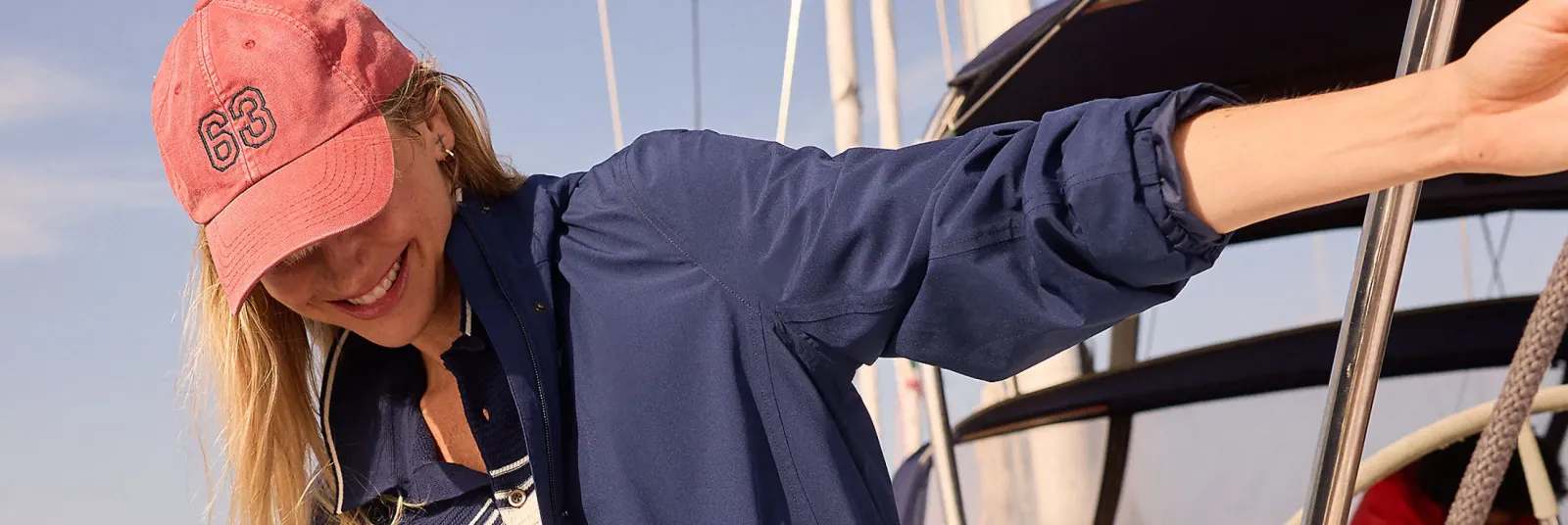
For women in their 30s, 40s and 50s, body shapes often evolve due to natural changes in muscle tone, posture or weight distribution. The jackets that once worked may no longer flatter, and generic sizing advice often doesn’t speak to the nuance of mature style. We know the frustration is real, which is why we created a practical, no-nonsense guide to answer this commonly-asked question: How should a jacket fit a woman of a certain age?
Specific Fit Indicators
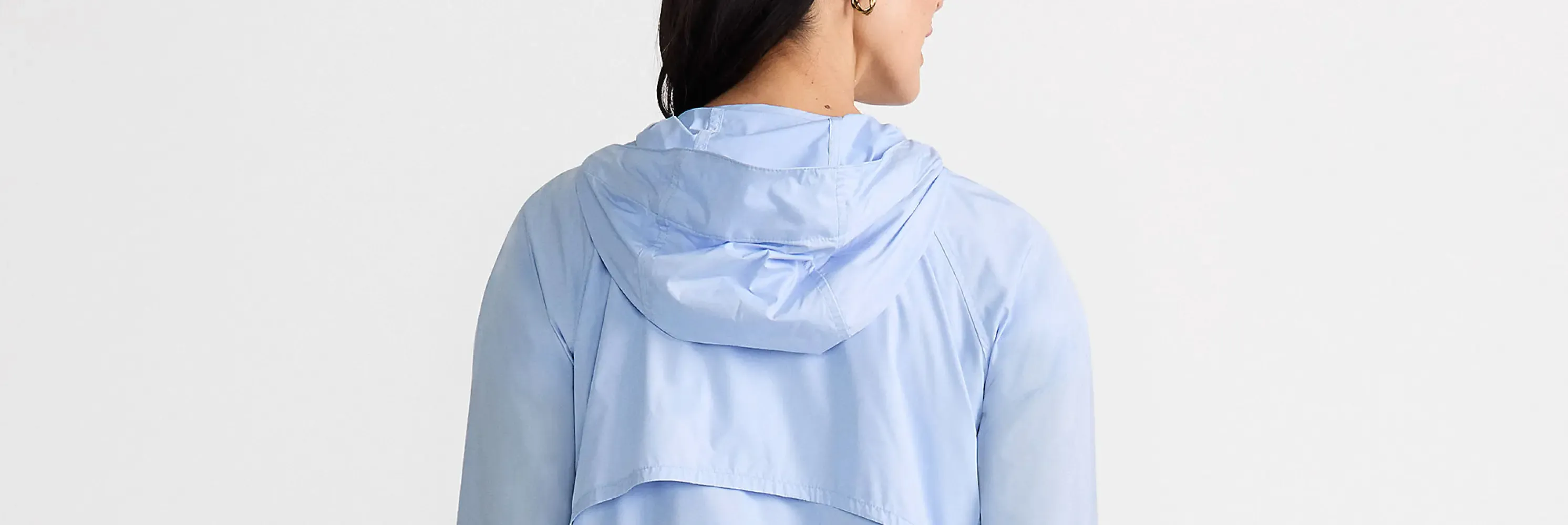
Understanding how women’s jackets should fit comes down to the details. These key points help ensure a flattering, functional fit, whether you’re buying a suit coat for work or a leather jacket for weekend wear. Here’s what to look for:
Shoulder Seam
The seam where the sleeve meets up with the jacket body should align with the edge of your shoulder bone. If it droops past your shoulder, the jacket may appear boxy or oversized. If it pulls inward or causes wrinkling, it’s likely too small. A well-placed shoulder seam lies flat, creating a clean, structured silhouette.
Chest
A properly fitted jacket allows you to button or zip it without gaping or pulling across the bust. You should be able to breathe and move comfortably but not be swimming in extra fabric. For women with fuller busts, a contoured fit or stretch fabric can offer ease without sacrificing shape.
Waist
The waist of a jacket should follow the natural curves of your body without clinging too tightly. Look for subtle tailoring or darts that create definition without exaggeration. If you notice bunching or a boxy fit when viewed from the side, consider sizing down or choosing a style with more waist shaping.
Sleeve Length
Sleeves should generally end just below the wrist bone. For blazers or suit coats, this allows your shirt cuff to peek out slightly, which is the sign of a polished fit. In more casual styles like bomber or denim jackets, ribbed or finished cuffs should sit at or just above the wrist.
Jacket Length
The most flattering jacket length depends on your height and the jacket style. A classic blazer often hits just below the hipbone, elongating the torso. Cropped styles like denim or bomber jackets should hit near the natural waistline or slightly lower. For plus or petite frames, look for proportions that flatter your vertical line without overwhelming or cutting you off.
Collar
The collar should sit flat against your neck without standing away or digging in. On structured pieces like a suit coat, it should sit snugly against the back of the neck with no visible gapping or bunching when buttoned.
Fabric Drape
A well-fitted jacket will drape smoothly across the shoulders and torso without pulling or sagging. Stiffer fabrics like wool or leather should hold their shape, while softer fabrics should skim the body. Pay attention to how the fabric moves when you walk or shift positions. This is where quality craftsmanship makes a difference.
Practical Tests for Size
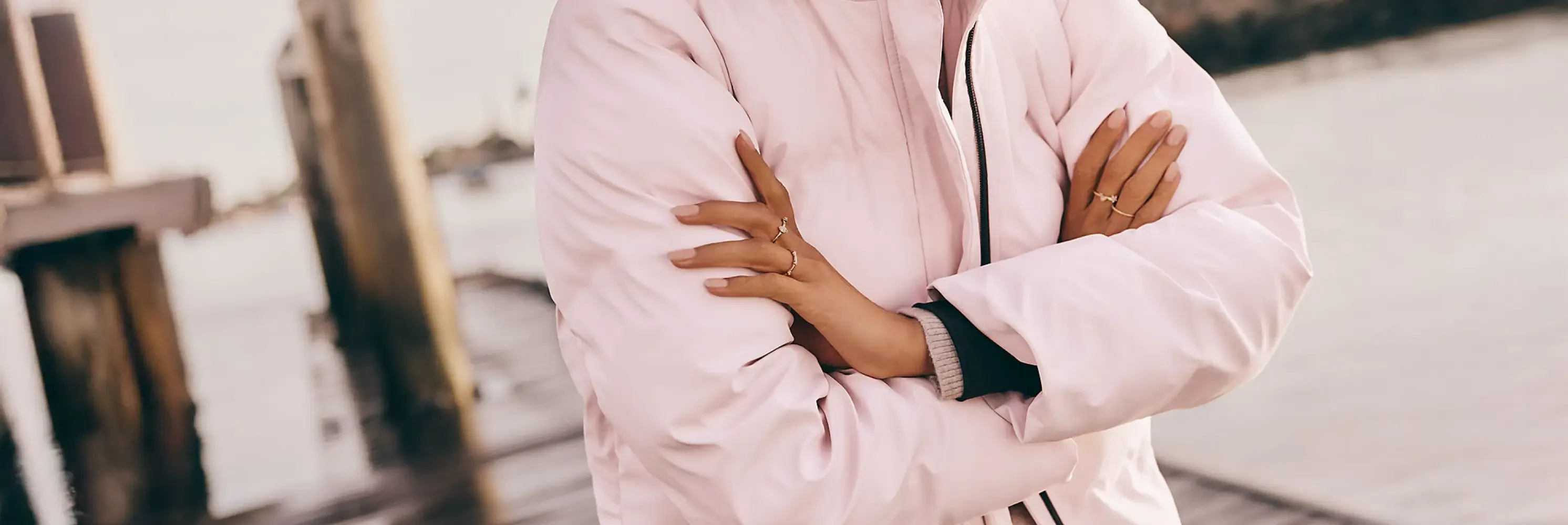
Even if a jacket checks all the boxes on paper, the real test is how it performs when you move. These simple, in-the-moment fit checks can help you determine whether a jacket works for your body and lifestyle.
The Hug Test
Reach forward and pretend you’re giving someone a big, cozy hug. If the jacket pulls tightly across your back, shoulders or bust—or if you feel restricted—that’s a sign it may be too small or too stiff. A quality jacket should flex with you, not fight against your natural range of motion.
Extend Your Arms
Lift your arms up, out and to the sides. Can you move freely, or does the jacket ride up, dig into your shoulders or bunch at the seams? Especially in structured jackets like suit coats or blazers, mobility is key. A little resistance is normal in more tailored pieces, but discomfort shouldn’t be.
Range of Motion
Twist at the waist, bend at the elbows and roll your shoulders gently. These natural movements mimic your everyday routine: typing at a desk, reaching for a bag, holding a coffee cup. The jacket should accommodate all of them without requiring constant readjustment.
Try Sitting, Standing and Walking
A jacket that feels great standing still might bunch awkwardly when you sit or shift. Sit down in a chair, cross your arms or walk a few paces. Watch for signs of pulling across the back, gaping collar or sleeves riding up. Your jacket should move with you, whether you’re in the office or out running errands.
Layering References
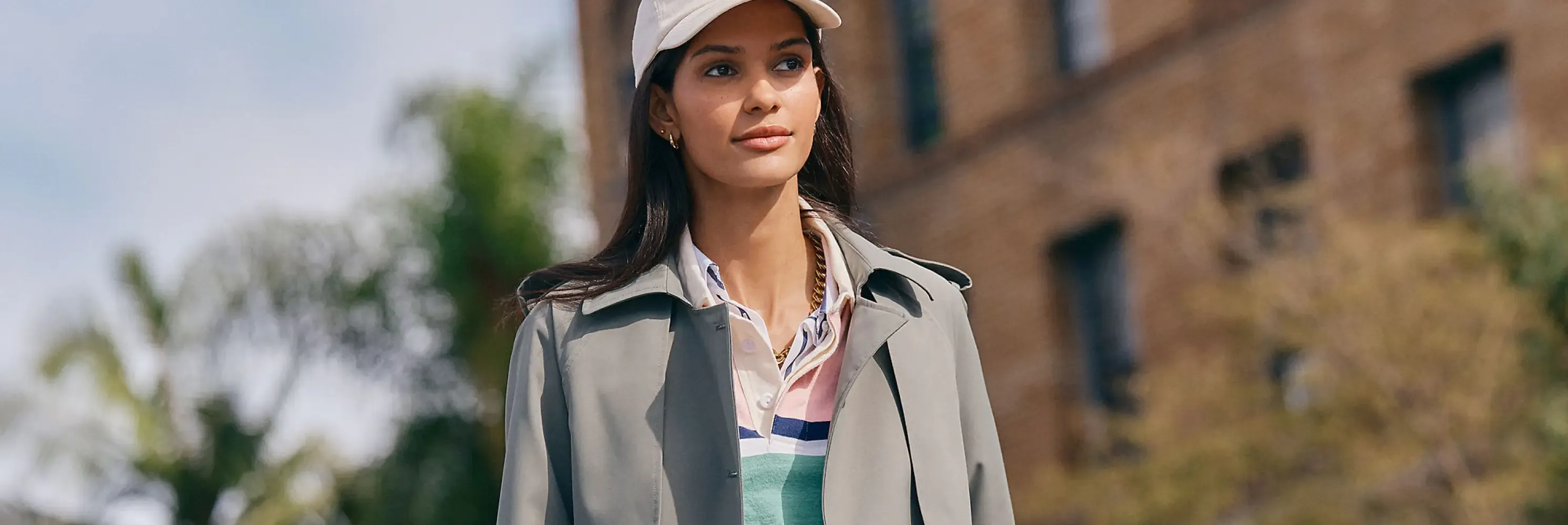
The versatility of a great jacket really shines when it comes to layering. Whether you’re dressing for crisp spring mornings or bracing for winter winds, the right fit should leave room for comfort without looking bulky or feeling restrictive. Here’s how to assess jacket fit through the lens of layering:
Layering in Warm Climates or Mild Weather
In warmer regions or transitional seasons, layering is often about breathability and light coverage. Here’s what to consider when wearing thinner base layers like cotton tees, lightweight blouses or sleeveless tops:
- Fit Tip: Your jacket should feel close to the body without clinging. There shouldn’t be any gaps at the back or underarms, but you also shouldn’t feel like the jacket is collapsing without added layers.
- Fabric Flexibility: Materials like cotton blends, linen or lightweight denim offer structure without added weight.
- Style Combinations: Pair a denim or bomber jacket over a sundress or a thin knit tee. The fit should still allow you to move freely and feel comfortable on warmer days.
Layering in Cool Climates or Colder Weather
Colder weather calls for cozy, strategic layers: think sweaters, thermals or even thin puffer vests underneath your jacket. A well-fitting jacket should accommodate these without distorting the silhouette or restricting motion.
- Fit Tip: Look for a slight allowance in the arms and torso. When zipped or buttoned over a sweater, the jacket should still maintain clean lines without feeling tight across the back or bust.
- Smart Materials: Wool blends, structured twill or quilted linings add warmth and shape while preventing bunching.
- Style Combinations: Layer a wool blazer over a turtleneck or wear a utility jacket over a waffle-knit top. The key is a smooth drape, even when the layers are thick.
Different Types of Jackets & How They Should Fit
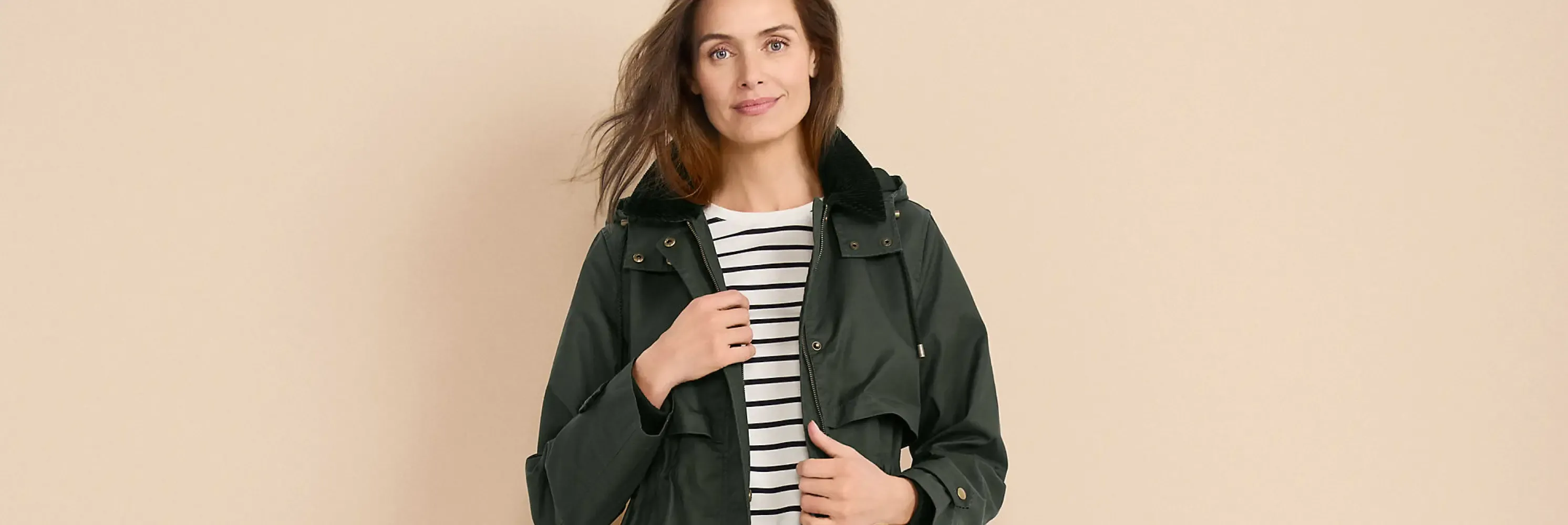
Not all jackets play by the same rules. Each style has its own personality and its own fit expectations. Whether you’re suiting up for a big presentation or throwing on a weekend layer, here’s how to ensure the right fit across the most popular styles.
How Should a Suit Coat Fit?
A suit coat (or suit jacket) is one of the most structured garments in a woman’s wardrobe, and the fit should reflect polish and professionalism. The shoulders must align cleanly with your natural frame, with enough room in the chest and waist to allow buttoning without pulling. Look for gentle contouring through the midsection, smooth sleeve lines and a hem that hits around the mid-hip. In motion, it should move with you, not bunch or gap, especially when layered over a blouse or lightweight sweater.
How Should a Blazer Fit?
Blazers are slightly less formal than suit coats but just as powerful in creating a pulled-together look. A modern blazer should skim your body: not too tight, not too boxy. Pay attention to sleeve placement and mobility through the shoulders. Many women prefer a little extra room in the torso for layering versatility. Cropped or hip-length blazers both work, just make sure the length complements your height and torso proportions.
How Should a Bomber Jacket Fit?
A bomber jacket is meant to feel relaxed and casual without drowning your shape. The shoulders should still hit in the right place, and the ribbed waistband should rest comfortably at or just above your hips. While there’s more forgiveness in the body and sleeves, you still want a clean fit across the chest with no ballooning or sagging. A well-fitting bomber adds edge and attitude without overwhelming your frame.
How Should a Denim Jacket Fit?
A denim jacket should feel like your favorite pair of jeans: structured, sturdy and reliable. Look for a snug (but not tight) fit through the shoulders and upper arms. The body can be slightly boxy or more tailored, depending on your style, but it shouldn’t gape when worn open or pinch when buttoned. Ideally, the hem hits at or slightly below the waist to flatter curves and balance proportions. Slight stretch in the denim adds comfort without compromising that classic look.
How Should a Leather Jacket Fit?
Leather jackets should feel like a second skin, only better. Fit is everything here: too tight and it restricts movement; too loose and you lose the sleek, structured silhouette. Focus on clean shoulder seams, smooth sleeves and just enough room in the torso for a thin knit layer underneath. Leather softens over time, so a close (but not constrictive) fit often yields the best long-term wear. Look for seams that follow your natural curves and allow comfortable movement through the shoulders and elbows.
Problem-Solution Framing
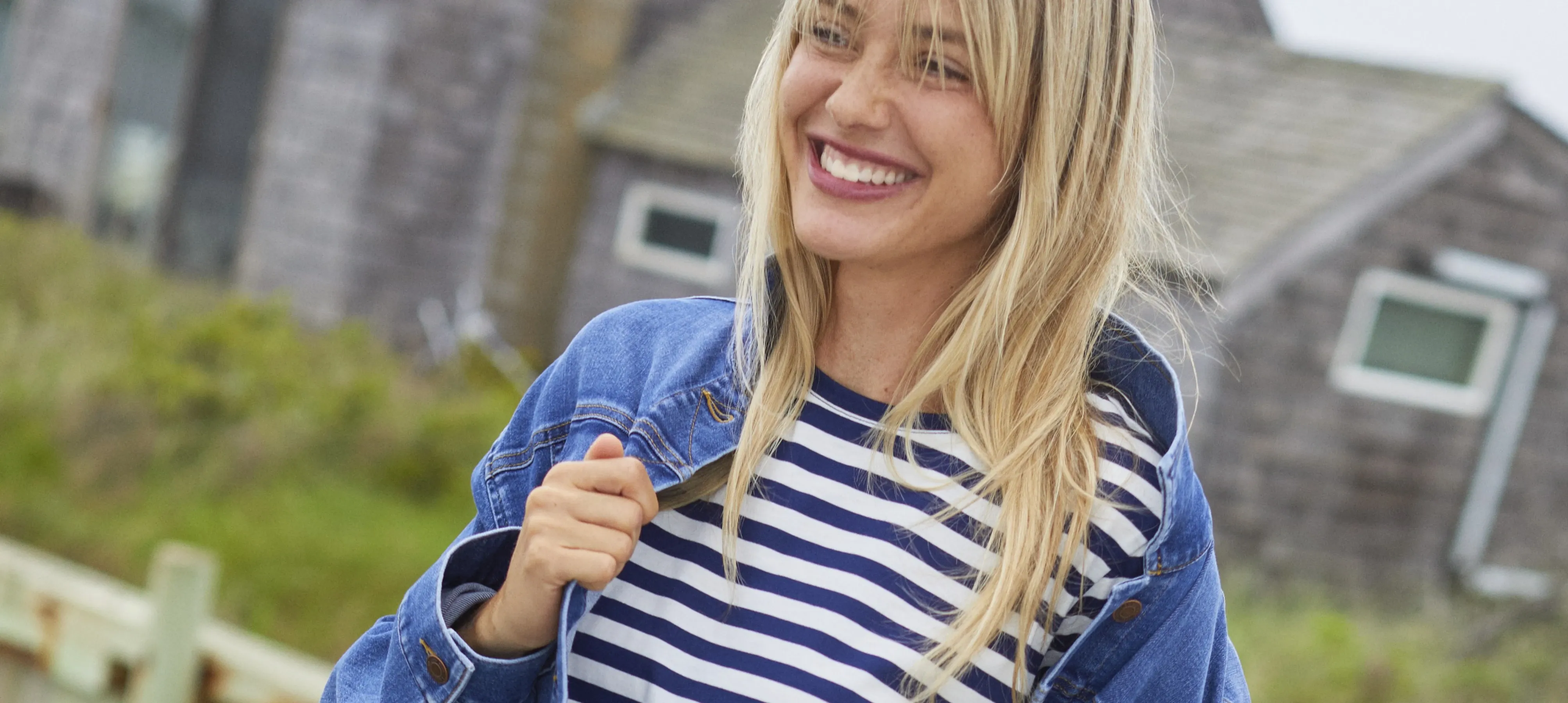
Everyone’s body is unique, and finding the right jacket isn’t always a matter of picking your usual size off the rack. Whether you’re petite, curvy or between sizes, the right fit can feel elusive, but it doesn’t have to be. Below are common jacket-fitting challenges women face, especially in midlife, and how to solve them with confidence and ease.
Jackets for Different Body Types
No two bodies are one-size-fits-all. Expect more from your jacket.
- Problem: Off-the-rack jackets often assume one “standard” body shape, which can lead to poor fit in the bust, shoulders or hips.
- Solution: Choose jackets with thoughtful tailoring, such as princess seams, adjustable waists or slight peplum details, that highlight your shape without clinging. Midlife shifts in weight or posture can be complemented with jackets that gently contour rather than compress.
In-Between Sizes
Stuck between sizes? You’re not alone.
- Problem: You try your usual size, and it’s too snug—but the next size up feels oversized and shapeless.
- Solution: Look for stretch fabrics or jackets designed with flexible fits. If you fall between sizes, consider layering goals. Size down for a fitted blazer over a blouse, or size up if you often wear sweaters underneath. Some jackets also offer inside drawstrings or side panels that subtly adjust to your needs.
Plus and Petite Sizing
When sleeves are too long or waists fall in the wrong place, it’s not you, it’s the sizing.
- Problem: Standard sizes don’t accommodate height, torso length or proportions, leading to bunching sleeves, misaligned waists or too-long hems.
- Solution: Seek out brands (like Lands’ End) that offer plus, petite and tall sizing made to flatter real proportions. Petite jackets have shorter sleeves and properly placed waists, while plus-size options include more room where you need it most without sacrificing shape or style. Reinforced seams and quality fabrics ensure lasting comfort and a polished look at every size.
Confidence Builders
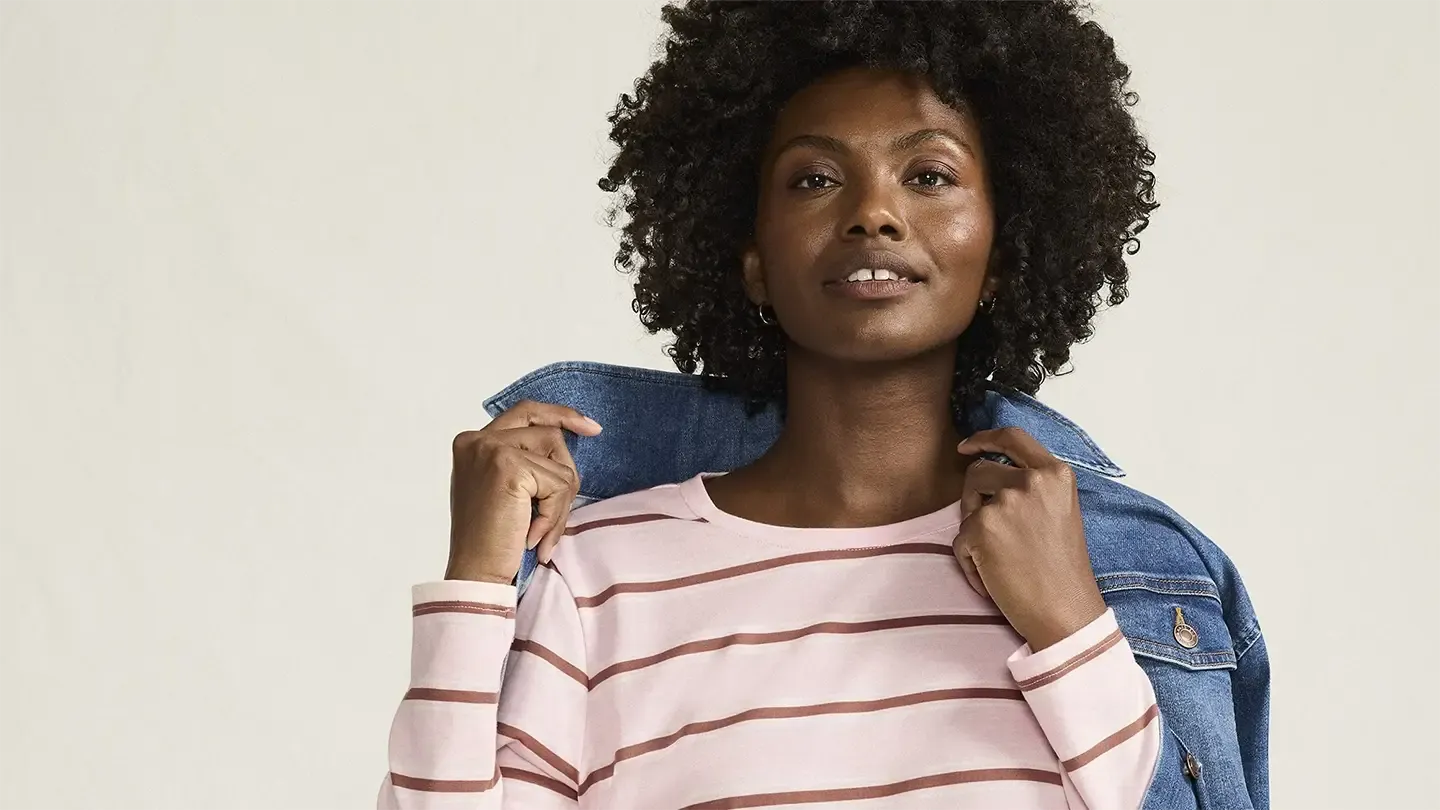
A great jacket shapes how you feel when you step out the door. The right fit doesn’t just flatter your body; it honors it. That’s especially powerful for women in their 30s, 40s and 50s, whose bodies may have shifted, softened or strengthened in ways the fashion industry hasn’t always celebrated.
So, here’s the truth: style isn’t about returning to how your body used to be; it’s about dressing for the woman you are right now. Whether you’re commanding a meeting in a structured blazer or heading to brunch in a well-worn denim jacket, that jacket becomes your armor, your attitude, your ease. You deserve clothes that support your lifestyle, adapt to your needs and move with your body at every stage of life.
The best fit? It’s the one that makes you stand a little taller and smile at your reflection.
Frequently Asked Questions
Still have questions about finding a jacket that fits you beautifully? Lands’ End has the answers. Here are some of the most common questions our customers ask about our jackets and how they fit.
Does Lands' End offer jackets in petite and plus sizes?
Yes! Lands' End carries a wide range of women's jackets in petite, plus, tall and regular sizes. These fits are thoughtfully proportioned, not just scaled up or down, to flatter your height, shape and curves in all the right places.
What if I'm between sizes?
We know that not every body-type fits into a single size category. Many of our jackets feature stretch fabrics, adjustable elements or relaxed tailoring for a flexible fit. We also offer detailed size charts and garment measurements to help you choose the right size for your layering needs and preferences.
Do Lands' End jackets hold their shape over time?
They do because we design them to last. Lands' End jackets are crafted with quality fabrics, reinforced seams and expert tailoring, so they maintain their structure and color even after repeated wear and washing.
How do I know which jacket style is best for my body type?
Each product page includes fit details, customer reviews and styling suggestions to help guide your choice. Whether you prefer structured blazers or relaxed bombers, our team works hard to offer flattering options for all body shapes and lifestyles.
Find Your Fit in Jackets at Lands’ End
The right outfit is about how it makes you feel. At Lands’ End, we believe every woman deserves a jacket that fits beautifully, lasts season after season and helps her show up with confidence. With extended sizes and timeless styles made to move with you, we’re here to make jacket shopping simple and satisfying. Explore our collection of Lands’ End jackets for women and discover your new favorite fit.
Shop all Women’s Outerwear